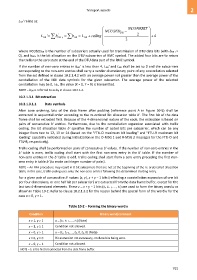Page 771 - 5G Basics - Core Network Aspects
P. 771
Transport aspects 2
LDR' relate as:
NCONEBIT
NCUSED DR
'
b
b
L DR ' DR i DR L DR ceiling 2 4
2
where NCUSEDDR is the number of subcarriers actually used for transmission of DTU data bits (with bDR-i >
0), and bDR-i is the bit allocation on the DTU subcarriers of RMC symbol. The added four bits are to return
the trellis to the zero state at the end of the DTU data part of the RMC symbol.
If the number of non-zero entries in bDR’ is less than 4, LDR’ and LDR shall be set to 0 and the subcarriers
corresponding to the non-zero entries shall carry a vendor discretionary point of any constellation selected
from the set defined in clause 10.2.1.4.2 with an average power not greater than the average power of the
constellation of the NOI data symbols for the given subcarrier. The average power of the selected
constellation may be 0, i.e., the value (X = 0, Y = 0) is transmitted.
NOTE – bDR is referred to as bd in clause 10.2.1.2.
10.2.1.3.1 Bit extraction
10.2.1.3.1.1 Data symbols
After tone ordering, bits of the data frame after padding (reference point A in Figure 10-5) shall be
extracted in sequential order according to the re-ordered bit allocation table b'. The first bit of the data
frame shall be extracted first. Because of the 4-dimensional nature of the code, the extraction is based on
pairs of consecutive b' entries. Furthermore, due to the constellation expansion associated with trellis
coding, the bit allocation table b' specifies the number of coded bits per subcarrier, which can be any
integer from two to 12, 13 or 14 (based on the "FTU-O maximum bit loading" and "FTU-R maximum bit
loading" capability indicated during initialization in the O-MSG 1 and R-MSG 2 messages for the FTU-O and
FTU-R, respectively).
Trellis coding shall be performed on pairs of consecutive b' values. If the number of non-zero entries in the
b' table is even, trellis coding shall start with the first non-zero entry in the b' table. If the number of
non-zero entries in the b' table is odd, trellis coding shall start from a zero entry preceding the first non-
zero entry in table b' (to make an integer number of pairs).
NOTE – An FRA procedure may result in 0-bit subcarriers that are not at the beginning of the re-ordered bit allocation
table; in this case, trellis coding uses only the non-zero entries following the determined starting entry.
For a given pair of consecutive b' values (x, y), x + y − 1 bits (reflecting a constellation expansion of one bit
per four dimensions, or one half bit per subcarrier) are extracted from the data frame buffer, except for the
last two 4-dimensional elements. These z x + y − 1 bits (tz, tz−1, ..., t1) are used to form the binary word u as
shown in Table 10-2. Refer to clause 10.2.1.3.2 for the reason behind the special form of the word u for the
case x 0, y > 1.
Table 10-2 – Forming the binary word u
Condition Binary word/comment
x 1, y 1 u (tz, tz−1, ..., t1) (Note)
x 1, y 1 Condition not allowed.
x 0, y 1 u (tz, tz−1, ..., t2, 0, t1, 0) (Note)
x 0, y 0 Bit extraction not necessary, no data bits being sent.
x 0, y 1 Condition not allowed.
NOTE – t 1 is the first bit extracted from the data frame buffer.
761

